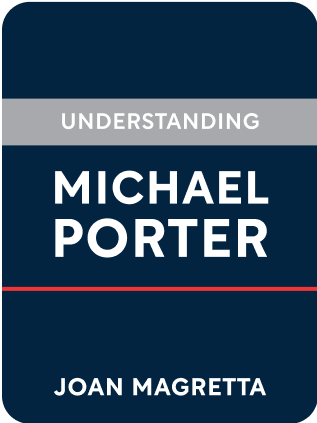

This article is an excerpt from the Shortform summary of "Understanding Michael Porter" by Joan Magretta. Shortform has the world's best summaries of books you should be reading.
Like this article? Sign up for a free trial here .
What is unique value in the context of business, and how do you create it?
Your unique value proposition is what you distinctively create for your customers. It says what your product is and who it serves (and implicitly how it’s different from competitors’ products). You need unique value to create a business plan and to sell your product.
Creating Value
The value proposition is the piece of strategy that looks outward at customers, the demand side. The value chain looks internally on operations. Strategy is integrative, bringing supply and demand sides together.
Unique Value Proposition
A distinctive value proposition answers three questions:
- Which customers are you going to serve?
- Which of your customers’ needs are you going to meet?
- What price will provide acceptable customer value and acceptable company profitability?
Value propositions tend to focus on one aspect as a pillar, with the other applying to varying degrees. For example, focusing on a particular customer need can blur traditional demographic bounds. Likewise, a company can focus on a demographic and serve most of their needs.
Compare your value proposition to your rivals. If you’re servicing the same customers, with the same needs, at the same price, you don’t have a strategy. You’re just competing to the best.
Less obviously, it’s possible to be stuck in the middle – if you try to be too many things, you’ll be outflanked by cost leaders on one side (who are “just good enough”) and by differentiators on the other side (who satisfy customers who want more). Avoid the temptation to serve more customers and offer more features.
Your value proposition may also imply advantages based on the Five Forces
Examples of a Unique Value Proposition
Serving a distinctive demographic
- Walmart began by servicing small towns with populations below 10,000, which other discount retailers deliberately stayed away from. (These towns could usually support only one store, increasing barrier of entry.)
- Progressive Insurance began by servicing higher risk customers that other insurance companies rejected. (With few alternatives, they had lower bargaining power.)
Serving distinctive customer needs
- Hertz provided cars at airports to business and leisure travelers. Enterprise focused on short-term rentals for city residents. One use case was for a driver whose regular car needed repairs; this led to insurance companies being buyers and making up a third of revenues.
- In turn, Zipcar offered even shorter rental periods of hours, and extreme convenience of location, booking, and simple pricing.
Focusing on a distinctive price point
- Focus on customers who are currently underserved (by building a premium offering), or overserved (by stripping away a premium offering).
- Traditional airlines focused on expansive service between any point A to point B, with perks like food built in. Southwest offered low-cost fares with no frills. It saw its competition as cars and buses, not other airlines.
Unique Value Chain
A good strategy delivers distinctive value through a distinctive value chain. It must perform different activities from rivals, or perform similar activities in different ways.
Otherwise, a “unique” value proposition delivered through the same activities will prohibit differentiation/cost advantage, leading to competition to be the best. Also, if the same value chain can deliver the same value proposition, it has no strategic relevance.
Even if the product looks identical, there are many opportunities along the value chain for differentiation – delivery, disposal, support, financing, and more.
When finding a new strategic position, starting with the value proposition is intuitive, but starting with the value chain is equally valid. This is what companies do when they identify their strengths, then figure out how they can apply it to a customer need.
Examples of Unique Value Chains
- How could Progressive make high-risk customers work financially, where others had failed? They further segmented groups to find pockets of lower risk – motorcycle riders over 40 years old; drivers with accident history who have children. They also decreased cost of accidents by having inspectors issue checks on the spot, thus decreasing lawsuits.
- Enterprise leased locations in the city rather than airport rental areas, which were more convenient for their customers and also cheaper. Their target customers were less picky about cars, allowing Enterprise to stock budget, older vehicles. It marketed to insurance companies and car dealerships, rather than expensive consumer ads.
- Low-cost, high-volume Aravind Eye Hospital operationalized eye surgery, optimizing surgeon’s time by prepping the next patient as the operation was ongoing.
- Southwest made a host of changes to support their lower prices. Where traditional airlines serviced every point A to point B through a hub and spoke model, Southwest offered fewer routes but flew direct. They flew from secondary airports that were often more convenient to cities and also lower cost for the airline. Southwest cut out frills like food and higher class seats. They decreased plane turnaround time through a first-come first-serve boarding process, reducing meals, and standardizing their fleet. Finally, where airlines jumped to travel booking sites like Expedia, Southwest adamantly maintained its own website, preventing price comparison.
You can determine unique value in several ways. Before you make your business plan, consider the unique value proposition and the uni\que value chain.

———End of Preview———
Like what you just read? Read the rest of the world's best summary of Joan Magretta's "Understanding Michael Porter" at Shortform .
Here's what you'll find in our full Understanding Michael Porter summary :
- How Porter's famous Five Forces help you analyze every industry
- How IKEA, Southwest Airlines, and Zara have ironclad, defensible strategies
- Why the best companies reject opportunities to focus on what they know






